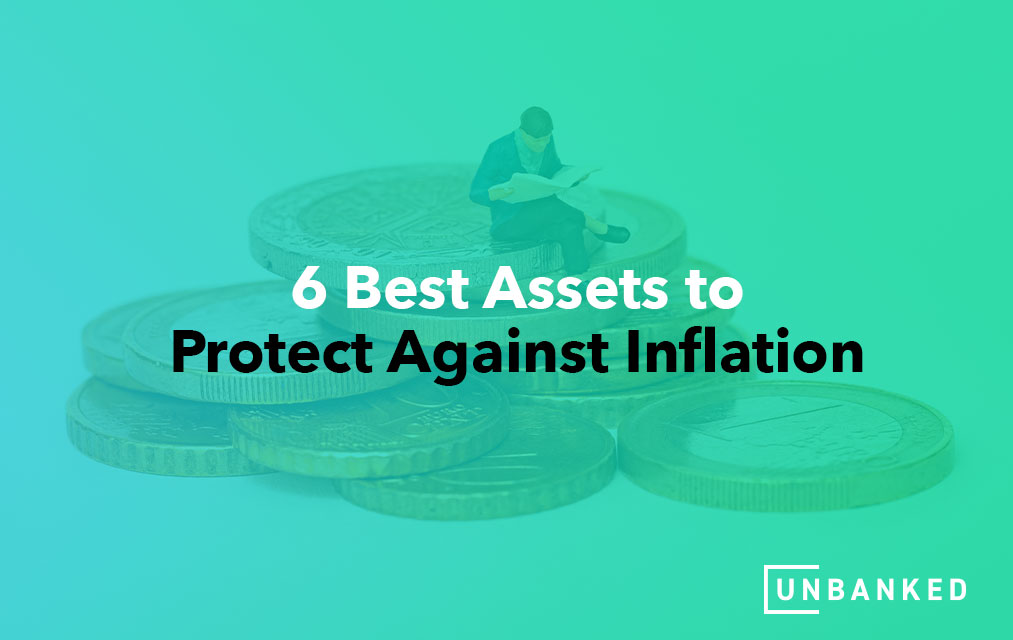In 10 years, a dollar will not purchase the same amount of products as it can today.
Inflation is to blame. Inflation refers to price rises over a certain period and is defined as the average price level of goods and services in an economy. As a consequence of inflation, a given quantity of cash will be worth less than before. As a result, finding the appropriate inflation-hedging techniques and investments is critical.
Investors constantly worry about inflation. This article will discuss what inflation means, what causes it, and the best assets to invest in to protect against it in 2021.
Related: Different Investing Strategies
What Is Inflation?
Inflation is the rise in prices as a whole, measured by the Consumer Price Index (CPI). In other words, when inflation rises, buying power declines. This indicates that as time passes, any given amount of cash, in this example, the US Dollar, can buy fewer products and services.
The average yearly inflation rate in the United States is approximately 2%. This is why it’s not a good idea to have a large amount of uninvested cash on hand, as it’ll likely just lose to inflation. Inflation is demonstrated by your parents’ memories of going to the movies and buying concessions for much cheaper than it costs today.
A central bank controls the supply to keep inflation under control. This moderate inflation is maintained because it encourages individuals to spend now instead of saving later, resulting in economic development. After all, today’s dollar is more valuable than tomorrow’s.
This relatively constant inflation is considered to enhance employment and the overall economic well-being by maintaining pricing stability.

Why Does Inflation Happen?
Inflation can happen in any of the following ways:
- Demand-pull inflation is caused by a demand that exceeds supply. A rising economy, a rise in the money supply, and increased government expenditure can all contribute to demand-pull inflation.
- Cost-push inflation occurs when salaries and manufacturing costs rise, but demand for products and services goes up or remains steady.
- Built-in inflation refers to the expectation that inflation would continue to grow over time, prompting businesses to raise prices to keep up with it. As a result of the price increase, consumers want greater salaries to keep up with growing living costs, which drives companies to raise prices more, continuing the cycle.
Inflation: Pros & Cons
Inflation may be beneficial to owners of assets such as real estate or commodities because rising prices allow them to be sold for a profit in the future—the investor gains at the customer’s expense.
Inflation that is “reasonable” is typically a sign of a healthy, expanding economy since it stimulates more lavish spending and investing. This is why maintaining a moderate amount of gradual inflation is generally good.
The possibility of fluctuating inflation creates uncertainty in both the economy and the stock market and isn’t beneficial for anyone. At various periods, this fluctuating inflation affects asset prices and wages. Prices also tend to grow quicker and sooner than salaries, adding to the economic downsides.
Do You Need to Protect Against Inflation?
People today seem to be especially worried about “inflation” and how they might “hedge” against it. Remember that inflation occurs at a pretty constant pace, which we aim to keep around 2% each year in the US.
When financial experts talk about “inflation concerns,” they’re referring to the possibility of inflation that is higher or progressing quicker than the average rate. The critical difference is that any “inflation hedge” one wants to implement is designed to minimize the negative consequences of unanticipated, above-average inflation.
That distinction is crucial because of the Efficient Markets Hypothesis, which states that all available information is already included in asset pricing. Many investors may not realize that this expected inflation is already included in the prices of stocks and bonds, meaning that it’s unlikely to harm your portfolio at its current rate, and you won’t need a “hedge” to compensate.
Furthermore, keep in mind that a prolonged period of above-average inflation in the United States is unusual. We hadn’t seen one since the 1970s when the government fundamentally altered the US monetary policy. We presently see record-low bond rates and high stock values, which may lead to a higher tendency for above-average inflation, but this will be temporary.
As a result of all of this, the best “inflation hedge” is probably higher portfolio returns, which are often accomplished by a stock-heavy portfolio, as they typically have the highest anticipated returns of all asset classes. Any specific allocation to an asset as an “inflation hedge” would almost certainly reduce your long-term overall return. In a moment, we’ll expand on this.
Any funds set aside for hedging should be modest since we’re dealing with an unlikely situation that will most likely be short-lived. So, regardless of what the fear-mongering headlines in the financial world might say, buy-and-hold investors with a higher risk tolerance should disregard the short-term noise and likely don’t require any specific position as an inflation hedge.
However, retirees or people with a lower risk tolerance may find this typical risk-return trade-off completely acceptable. For these investors, unanticipated inflation may be especially harmful. We’ll address them in the next section when we discuss which assets are the best at protecting against inflation.

Inflation Reduces Your Money’s Buying Power
Low inflation is beneficial to the economy, but it is detrimental to your money. A $1 bill will only be worth $0.95 cents next year if inflation rates reach 5%. It’s not only cash that depreciates in value. It’s not only cash that depreciates in value.
Low-interest accounts lose money during inflationary periods because the decrease in value offsets the interest they pay. In fact, any investment with a fixed interest rate will suffer a decrease in real dollars when inflation occurs. While all investors are affected by inflation, income-oriented investors are particularly hard hit.
Which Assets Can Beat Inflation?
Several asset types, in particular, are well-suited to inflation-based investment.
- Appreciation-oriented assets: Invest in assets that provide growth or appreciation rather than just income. A good example is company stock.
- Real assets: Nominal assets, such as CDs and conventional bonds, are devalued by inflation since they are priced based on the fixed interest they pay, which loses value as inflation rises. Real assets, on the other hand, are physical items having intrinsic worth. As a result, their value rises in tandem with inflation.
Assets with a variable interest rate: In an inflationary economy, something that pays a fixed rate will lose money. Assets with variable interest rates provide your money with a better chance of surviving since they will grow in tandem with inflation.
How to Protect Against Inflation: The 6 Best Assets
So, which assets are ideal for individuals who want to hedge their investments against inflation?
- Real Estate Investment Trusts
Companies that own real estate with the purpose of producing income are known as real estate investment trusts (REITs). When inflation rises, so do property values and rental revenue. As a result, REITs pay dividends to their shareholders.
There are certain disadvantages to REITs, including their susceptibility to demand high-yield assets. In addition, Treasury assets become more appealing when interest rates increase, causing money to leave REITs, lowering their stock values.
Property taxes, which may account for up to 25% of operating costs, must also be paid by
REITs. If state or local governments elect to raise property taxes to make up for budget deficits, they will substantially reduce the payment to shareholders. Finally, although REITs provide large returns, dividends must be taxed. Because a large proportion of REIT dividends is considered ordinary income taxed at a higher rate, the tax rates are generally higher than most dividends are presently taxed at.
2. Commodities
Grain, oil, electricity, and precious metals are all commodities, as are foreign currencies and emissions. Commodities and inflation have a unique connection, in which commodities serve as a predictor of future inflation. The price of the goods that a commodity is used to create increases in tandem with the price of the commodity.
Before investing in commodities, it’s essential to understand that they are very volatile, and investors should approach commodity trading with care. Because commodities are based on demand and supply, even a slight shift in supply may hurt commodity prices.
3. Gold
Gold is thought to be a good inflation hedge. Many individuals have turned to gold as its own currency, especially in nations where the national currency is depreciating. When their currency fails, these nations often resort to gold. Gold is a genuine, tangible asset that, for the most part, maintains its worth.
4. Stocks
A 60/40 stock/bond portfolio is typically a safe bet with a conventional combination of equities and bonds.
A simple, uncomplicated investing plan is a 60/40 stock/bond portfolio. It does, however, have certain drawbacks, as do any investment schemes. For example, a 60/40 portfolio will typically underperform over time when compared to an all-equity strategy. Furthermore, due to the impact of compounding interest, a 60/40 portfolio may substantially underperform an all-equity portfolio over extremely long periods.
It’s essential to remember that although a 60/40 portfolio can help you protect against inflation, you’ll likely lose out on rewards compared to a portfolio with a more significant equity proportion.
Related: How To Buy Stocks
5. Leveraged Loans
Leveraged loans are given to a company that already has a lot of debt or a bad credit rating. These loans are more costly to the borrower since they have a greater chance of default.
Collateralized loan obligations (CLOs) are the most common name for leveraged loans. In CLOs, the loans have been bundled into a single security. The underlying loans make periodic debt payments to the investor. CLOs usually offer a variable rate yield, making them an excellent inflation hedge.
Leveraged loans, like any other investment, entail a trade-off between benefits and dangers. Credit default, liquidity, and fewer safeguards are some of the dangers of investing in leveraged loans.
Leveraged loan borrowers may be forced to close their businesses or become unable to pay their obligations. Leveraged loans may be more difficult to buy or sell than publicly listed assets. Finally, compared to conventional loans, leveraged loans have fewer limitations in place to safeguard the lender. If the borrower can’t repay the loan, this may expose a fund to larger losses.
6. Real Estate Income
The money generated by renting a property is referred to as real estate income. With inflation, real estate works wonderfully. When inflation increases, property prices rise as well, lowering the amount an owner may demand for rent. As a consequence, the landlord will be able to generate a larger rental revenue over time.
This inflation allows you to keep up with the rising costs of housing. As a result, real estate income is an effective method to protect against inflation.
Real estate investing, like any investment option, comes with advantages and disadvantages. To begin with, the transaction expenses of buying real estate are higher than other investments. Second, real estate investments are not liquid, which means they can’t be sold fast and readily without losing a significant amount of money. If you buy a house, you’ll pay for management and upkeep, which may rapidly mount up. Finally, real estate investment entails assuming a significant amount of financial and legal risk.

Sectors That Can Protect Against Inflation
Specific sectors can handle inflationary risks like physical assets, commodities, and inflation-protected bonds better than others. A well-balanced portfolio is another valuable inflation hedge outside of these areas.
Real estate and REITs account for the majority of tangible assets. Inflation benefits real estate investors for several reasons:
- It functions as a discount on debt by increasing equity.
- It boosts rental revenue for property owners.
- It has no negative influence on property prices.
REITs are a good option if you don’t currently own property since they build value in high-inflation conditions.
Commodities are another way to protect against inflation. Because of how they are priced, the falling dollar is really beneficial to them. Similarly, if the price of a commodity rises, so does the price of the items that the commodity is used to make.
TIPS bonds are a terrific method to keep your bond investments safe even when inflation is high. While traditional bonds are hazardous and subject to losses during inflation, TIPS can assist in hedging against it.
Finally, a well-balanced portfolio is a fundamental inflation hedging technique. Focusing on a 60 percent stock, 40 percent bond, and zero percent cash portfolio can assist control inflation risk while still providing long-term return potential. However, the loss of additional gains that may be obtained by betting on equities is a source of concern. As a result, this is a highly cautious investing approach that may not always stand up for changing economic conditions.
Sectors To Avoid for Inflation Protection
Traditional bonds are one area of worry when avoiding investing sectors. It is fair to assume that the Fed will raise interest rates, which will impact the typically low-risk bond market. Investors like to avoid bonds that are deemed interest-rate sensitive.
Furthermore, growth stocks should be avoided by investors. Growth companies have a modest cash flow now but are expected to grow steadily over time. These equities contrast with value stocks, have substantial cash flows now but may drop in the future.
Growth stocks are badly impacted by rising inflation, whereas value stocks are favorably influenced, according to discounted cash flow calculations and the assumption that interest rates will fluctuate. As a result, investors like to avoid growth equities since their future cash flows will be impacted by today’s inflation.
Inflation’s Impact on Stocks and Bonds
Understanding the impact of high inflation on stocks and bonds is critical for proactively managing a portfolio during times of high inflation.
Bonds are known for being steady, low-risk, and ideal hedges against stock market volatility. Unfortunately, inflation has a negative impact on the bond market. When inflation grows, the Fed raises interest rates to reduce borrowing, causing the dollar’s value to fall even as the cost of products rises, and spending power decreases. As a result, bond rates rise as investors seek compensation for the risk of inflation. As investors lose interest in the bonds, the price will eventually fall, decreasing the value of your investment.
While this isn’t good news for bond investors, TIPS bonds alter their principal value based on inflation. During this time, it’s also necessary to focus on other assets.
Another Inflation Hedge Option: TIPS
A relatively new financial instrument known as Treasury Inflation-Protected Securities (TIPS) is the only asset that is genuinely tied to inflation.
TIPS are bonds linked to the Consumer Price Index; thus, they grow in lockstep with the CPI. This is exactly what investors look for in an inflation-protected asset. Their limited long-term yield is, of course, the trade-off. TIPS will offer lesser returns if inflation is lower. TIPS will offer greater returns if inflation is higher.
A retiree’s usual rule of thumb is to invest approximately half of their income in TIPS since significant unanticipated inflation may be catastrophic for a retiree’s portfolio, from which monthly withdrawals are required to meet expenditures, but no new deposits are coming. Short- and intermediate-term nominal bonds would also likely be a significant part of the retiree’s portfolio.
TIPS are clearly more essential for people with a bond-heavy portfolio, but various funds exist to adapt the TIPS length to the investment horizon.
Debt & Dealing With Inflation
Debt would appear to be the polar opposite of an investment. When inflation is high, though, incurring it might be a smart financial decision.
As long as the loan has a set interest rate, inflation makes it cheaper to service some forms of debt. Inflation lowers the value of your cash in the same manner as it lowers the value of your loan. This is beneficial to people who took out loans or mortgages before the inflationary period began.
For example, $1 from 1990 is roughly $2 now, so a $1,000 mortgage payment made 30 years ago is worth around $2,000 today. However, you’d still be paying $1,000 each month after all that time. As a result, the cost of what you must pay is cut in half. You’re effectively paying half as much to repay the loan each month.
If you have the option, refinance your loan or mortgage to a fixed rate instead of a variable rate. This will let you take advantage of inflation.
Do You Need More Inflation Protection?
It’s a good idea to take stock of what you have in your investing portfolio before making any changes. Most broadly diversified mutual funds and ETFs already include oil and energy firms, mining operations, real estate companies, and other classic inflation stalwarts, albeit perhaps not in the weightings you choose.
Energy equities, for example, account for less than 3% of the broad S&P 500. Companies in the materials industry and those in the real estate industry are in the same boat.
If you want to pack extra punch into your portfolio, try investing a little more in inflation-protected assets like natural resources or commodities firms, but don’t go overboard. As a general guideline, devoting 10% to 20% of an already well-diversified portfolio to these regions would generally work.
Are You Protected Against Inflation?
Inflation occurs on a regular basis, preferably at a regulated rate by a bank. This projected inflation has already been incorporated into asset pricing. Some investors worry about the possibility of unexpectedly large inflation.
The inflation rate in a given economy fluctuates based on current circumstances. Inflation is caused by two factors: rising salaries and fast rises in basic commodities. In the market economy, inflation occurs naturally. There are many methods to protect against inflation; for example, a diligent investor may prepare for inflation by making investments that outperform the overall market during periods of high inflation.
Hungry for more investing knowledge? Check out the free guides and resources at Unbanked!





